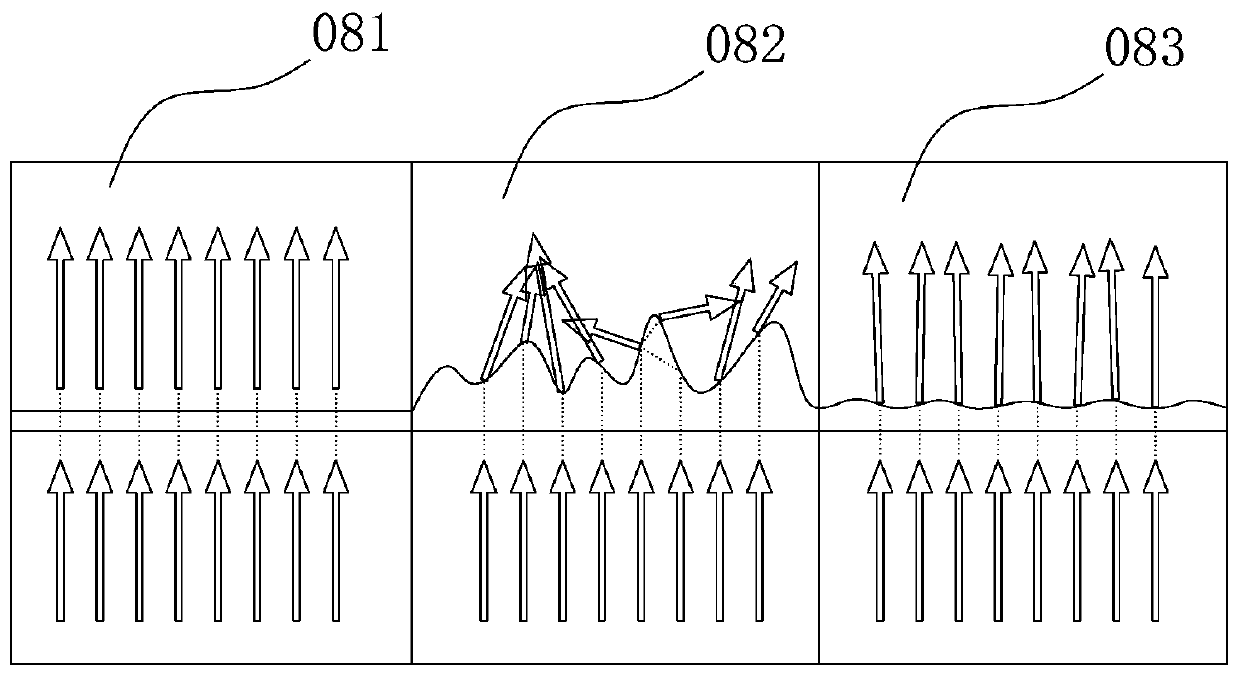Sensor dimming sheet and preparation method thereof
A sensor and light adjustment technology, applied in optics, instruments, optical components, etc., can solve the problem of controlling high-purity body scattered light without emphasizing surface scattering interference, not having scattering controllability, and not aware of high-purity body scattering control methods Advantages and other issues
- Summary
- Abstract
- Description
- Claims
- Application Information
AI Technical Summary
Problems solved by technology
Method used
Image
Examples
Embodiment 1
[0192] Such as Figure 13 As shown, the dimming sheet provided by the present invention includes a dimming layer 1 and a base 0. The dimming layer 1 is placed on one surface of the base 0. The thickness H of the base is 0.05 mm. The base includes a light-incident surface 001 and a light-emitting surface 002. The thickness T of the light-adjusting layer is 50 μm. The light-adjusting layer includes a propagation medium 1A and a light-scattering agent 1B, a light incident surface 101, and a light-emitting surface 102. The light-scattering agent 1B is uniformly dispersed in the propagation medium 1A to form a volume scattering system. Input The light 01 is emitted from the light-emitting surface 00 of the input light source, passes through the light-incident surface 001 and the light-exit surface 002 of the substrate in turn, and then enters from the light-incidence surface 101 of the light-adjusting layer, and is controlled by the volume scattering of the light-adjusting layer. 1...
Embodiment 2-15
[0209] For the dimmer provided in Example 1, the thickness H of the substrate is 0.15 mm, the roughness Ra of the light incident surface 001 and the light exit surface 002 of the substrate is Ra<0.05 μm, the substrate is a glass substrate, and the material 0A is silicate glass , and the other parameters are listed in Table 3.
[0210] Table 3 Performance comparison of embodiments 2-15 under collimated input light
[0211]
[0212]
[0213] Notes 1 to 3 are the same as Table 2
[0214] Comparing Examples 2 to 5, 6 to 8, and 9 to 10, it can be seen that when other conditions remain unchanged and T increases, the volume scattering effect is strengthened, Φ 2 becomes larger, the output light gets closer and closer to the ideal Lambertian level. Comparing Examples 11 to 13, it can be seen that when other conditions remain unchanged and D' increases, the volume scattering effect is strengthened, and Φ 2 becomes larger, the output light gets closer and closer to the ideal La...
Embodiment 16-31
[0216] For the dimmer provided in Example 1, the thickness H of the substrate is 0.15 mm, the roughness Ra of the light incident surface 001 and the light exit surface 002 of the substrate is Ra<0.05 μm, the substrate is a glass substrate, and the material 0A is silicate glass , and the other parameters are listed in Table 4.
[0217] Table 4 Performance comparison of Examples 16-31 under different forms of input light in the normal direction
[0218]
[0219]
[0220]
[0221] Notes 1 to 3 are the same as Table 2
[0222] As shown in Table 4, comparing Examples 16 to 19, it can be seen that for a specific sensor light-adjusting layer, when the normal direction is collimated and incident (Example 16), the Φ of the output light 2 When it is less than 120°, the ideal Lambertian body level is not reached. At this time, with the input light Φ 1 becomes larger, the volume scattering effect will be further strengthened, Φ 2 becomes larger and closer to the ideal Lamberti...
PUM
| Property | Measurement | Unit |
|---|---|---|
| surface roughness | aaaaa | aaaaa |
| thickness | aaaaa | aaaaa |
| particle diameter | aaaaa | aaaaa |
Abstract
Description
Claims
Application Information
 Login to View More
Login to View More - R&D
- Intellectual Property
- Life Sciences
- Materials
- Tech Scout
- Unparalleled Data Quality
- Higher Quality Content
- 60% Fewer Hallucinations
Browse by: Latest US Patents, China's latest patents, Technical Efficacy Thesaurus, Application Domain, Technology Topic, Popular Technical Reports.
© 2025 PatSnap. All rights reserved.Legal|Privacy policy|Modern Slavery Act Transparency Statement|Sitemap|About US| Contact US: help@patsnap.com



